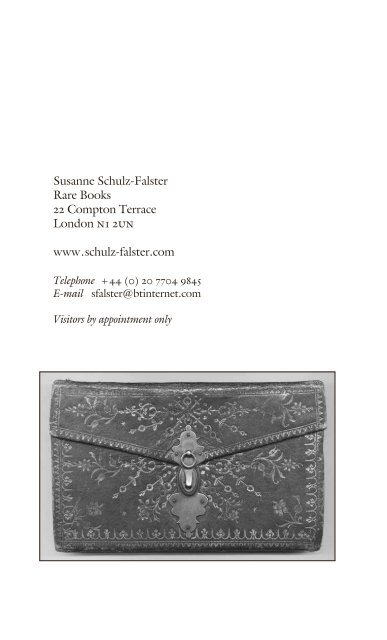Susanne Schulz-Falster Catalogue Eighteen - International League ...
Susanne Schulz-Falster Catalogue Eighteen - International League ...
Susanne Schulz-Falster Catalogue Eighteen - International League ...
Create successful ePaper yourself
Turn your PDF publications into a flip-book with our unique Google optimized e-Paper software.
<strong>Susanne</strong> <strong>Schulz</strong>-<strong>Falster</strong><br />
Rare Books<br />
22 Compton Terrace<br />
London n1 2un<br />
www.schulz-falster.com<br />
Telephone +44 (0) 20 7704 9845<br />
E-mail sfalster@btinternet.com<br />
Visitors by appointment only<br />
1. [ACADEMY – MANTUA.] Codice della Reale Accademia di<br />
Scienze Belle Lettere ed Arti di Mantova. Mantua, Giuseppe Braglia,<br />
1794. £1,250<br />
4to, pp. lxxv, [1]; title vignette; contemporary catspaw calf, flat spine<br />
with gilt decoration; a very crisp and wide-margined copy.<br />
First edition of the rules and regulations of Royal Academy of Arts and<br />
Sciences of the Northern Italian city of Mantua, which flourished under<br />
the rule of the Austrians and had Archduke Ferdinand as its sponsor. The<br />
founding of an academy had been first set in motion under Maria Teresa in<br />
1767, with the indication that not only members from the Accademia dei<br />
Timidi, but also from the Colonia Arcadica Virgiliana (founded in 1752,<br />
but like the Timidi having roots going back to the Invaghiti of 1562),<br />
would be eligible for membership in the new academy (Maylender, v.5,<br />
pp. 470–471).<br />
The founding statutes extend to twenty-nine paragraphs and specify the<br />
range of the academy, which is to include among the sciences, philosophy,<br />
mathematics, physics, then literature, and also agriculture and medicine.<br />
The arts included painting, sculpture, architecture, decoration, music, and<br />
mechanical arts. In the statutes internal organisation, election of officials,<br />
association, and reciprocal arrangements with other academies are clarified.<br />
It is interesting to note that a separate class was dedicated to arts and<br />
crafts, which indicates the increasing interest in applied technology. The<br />
work concludes with a listing of all the members and officials of the society,<br />
including academicians with voting rights.<br />
OCLC: UCLA, Bibliothèque Nationale, BL and Berlin; see M. Maylender, Storia<br />
delle Accademie d’Italia. Bologna, 1926–1930.<br />
Wallet-Style Binding<br />
2. [ALMANAC.] RIDERS, Cardanus [pseud.]. Riders British<br />
Merlin: for the Year of our Lord God, 1776. Being the Bissextile, or<br />
Leap Year. Adorned with many delightful and useful Verities fitting<br />
all Capacities in the Island of Great Britain’s Monarchy. With notes<br />
of husbandry, fairs, marts, high roads, and tables for many necessary<br />
uses. London, Company of Stationers, 1776. £1,000<br />
12mo, pp. 60, first part interleaved; title printed in red and black,<br />
headlines and saints’ days printed in red throughout; half page<br />
anatomical woodcut of the ‘zodiacal’ man, showing the organs and parts<br />
of the body controlled by various signs of the zodiac; contemporary<br />
London red goatskin wallet-style binding, sides decoratively gilt;<br />
with silver clasp intact; some extra pages bound in for note-keeping,<br />
including two coated leaves for marking with a stylus; tax stamp visible<br />
on title; contemporary manuscript notes on blanks; an attractive copy.<br />
Riders’ British Merlin was one of the longest running British almanacs,<br />
published under the control of the Stationers’ Company from 1656 to<br />
catalogue eighteen
















